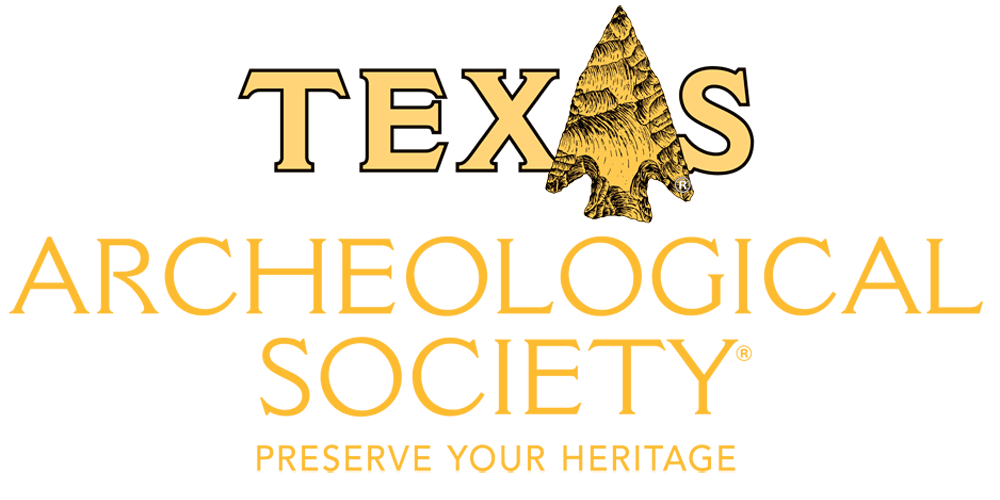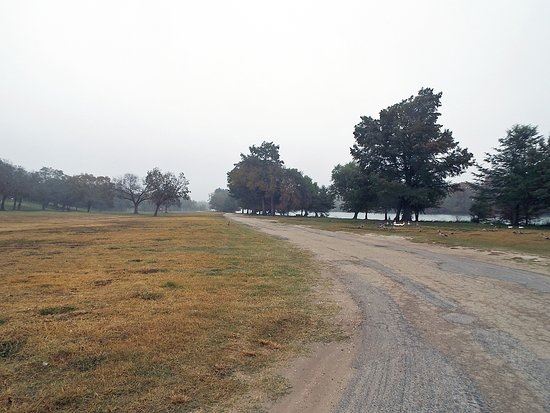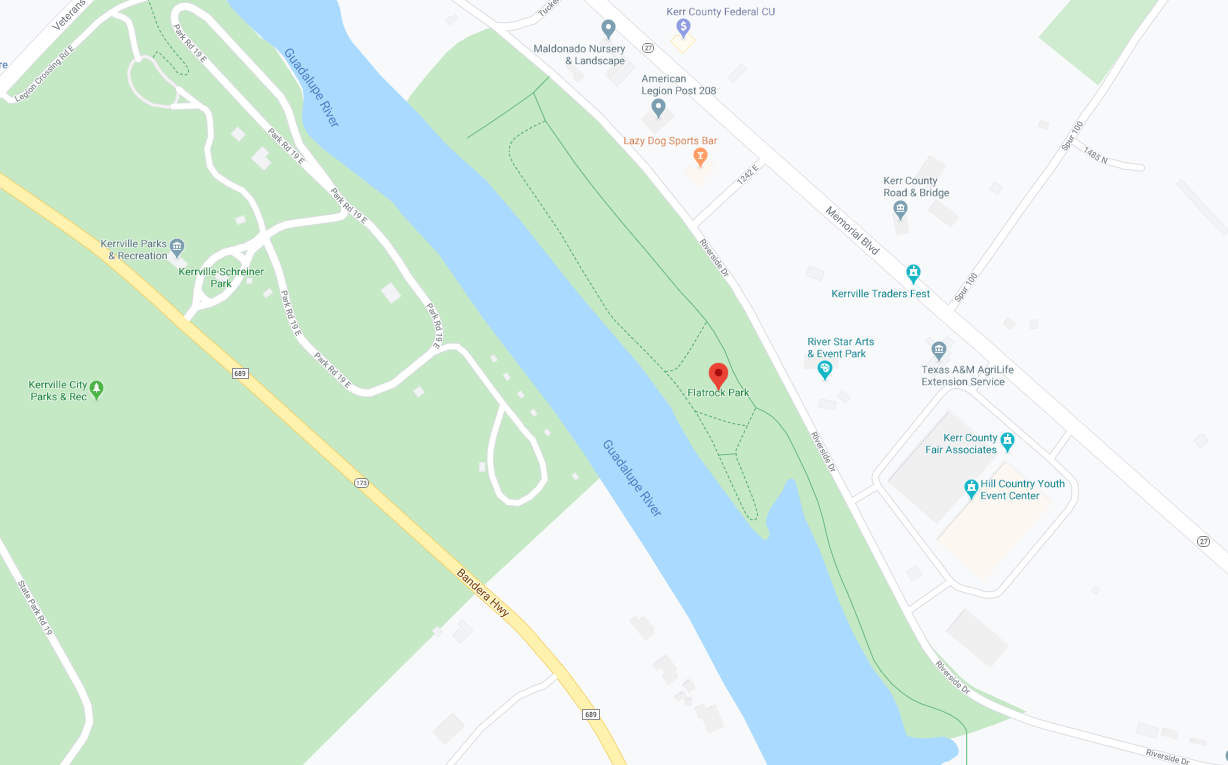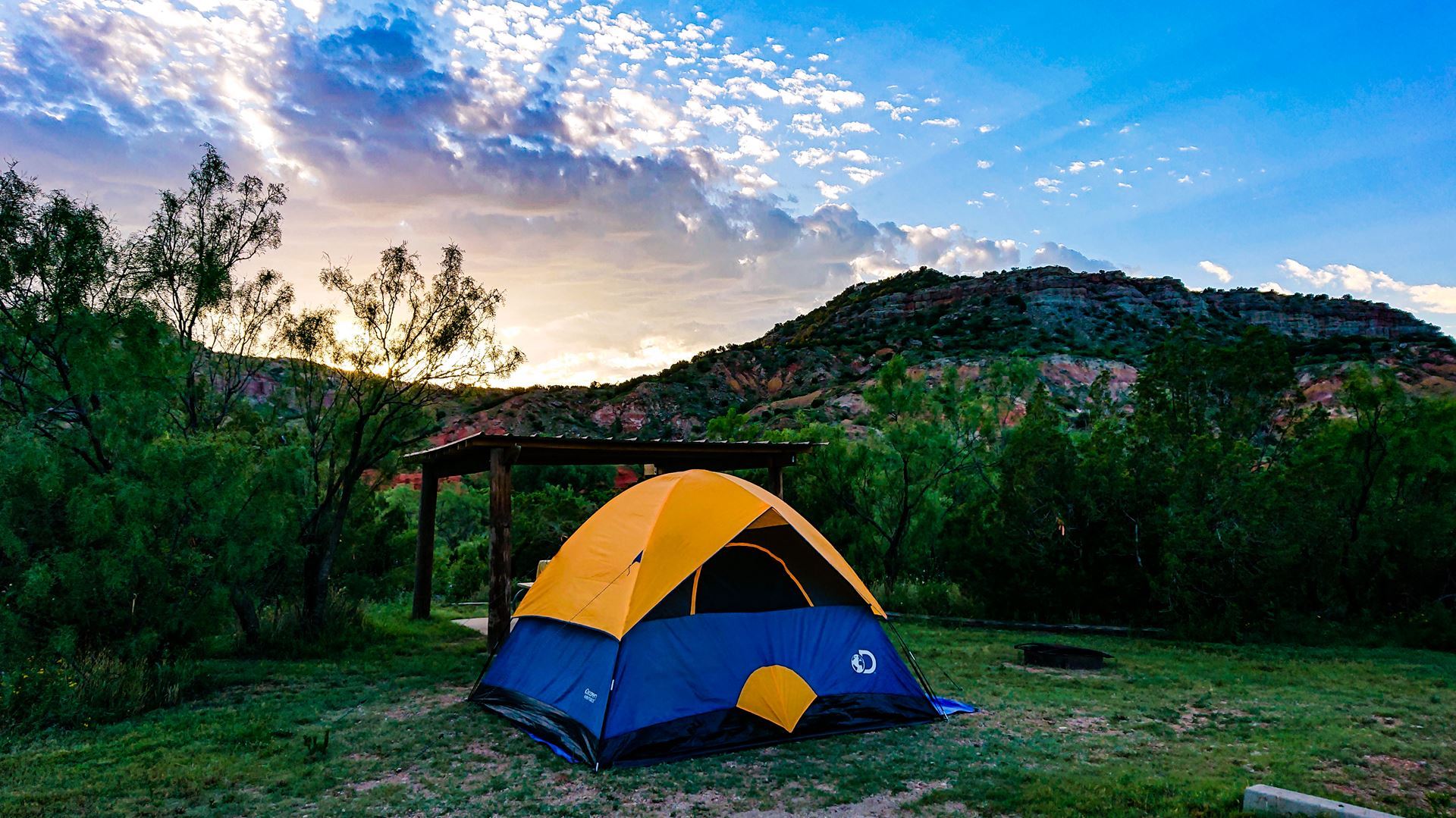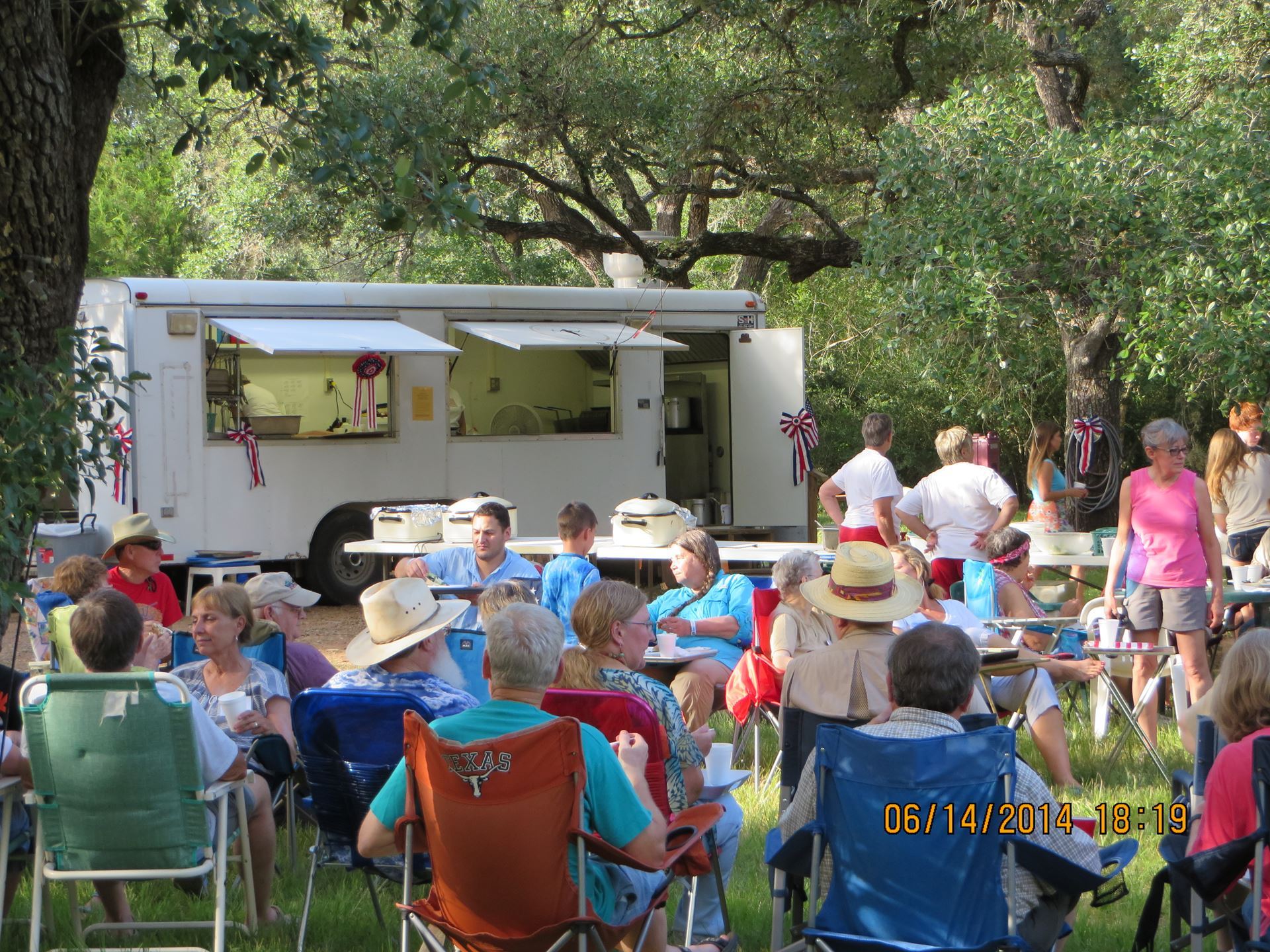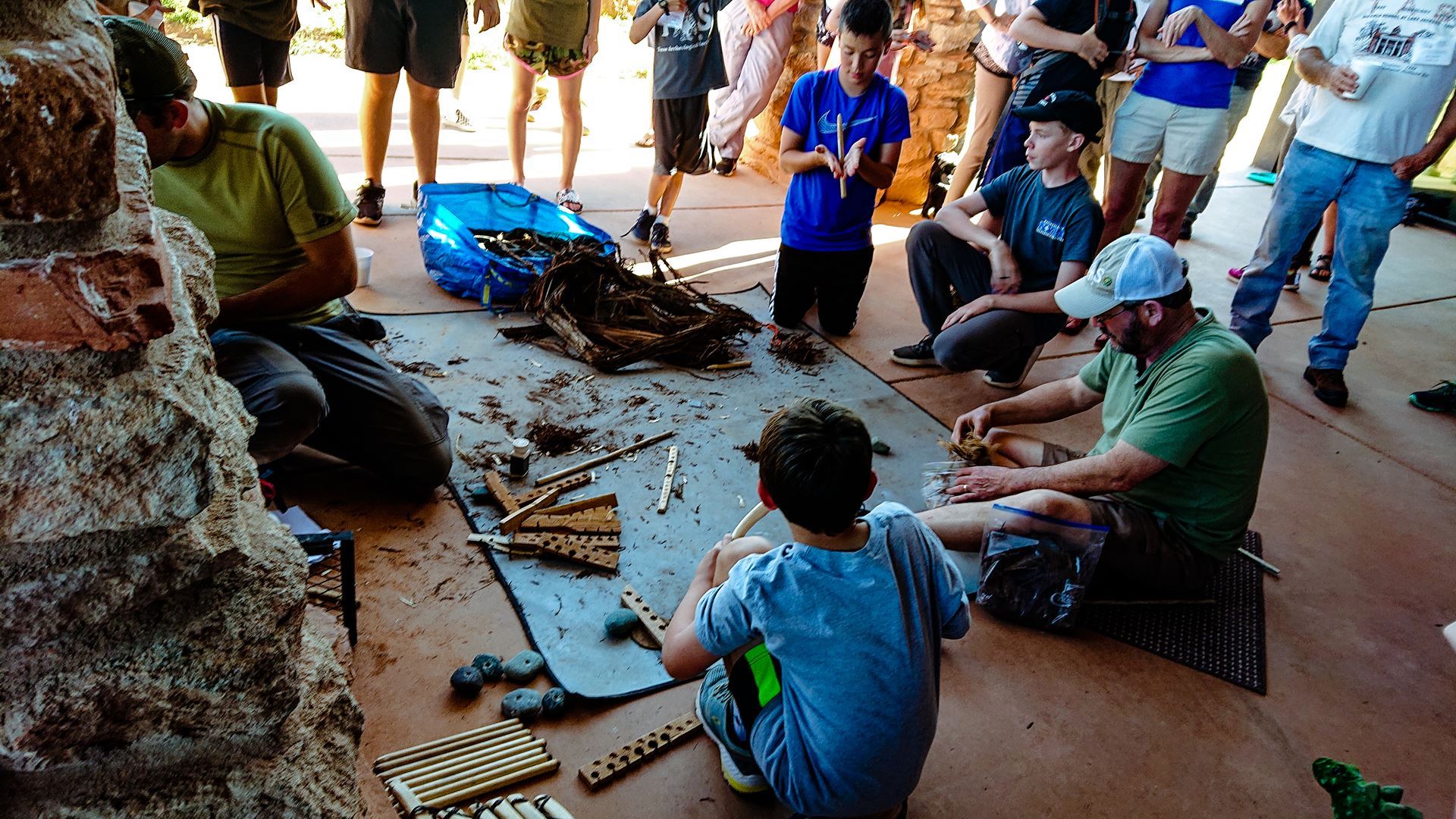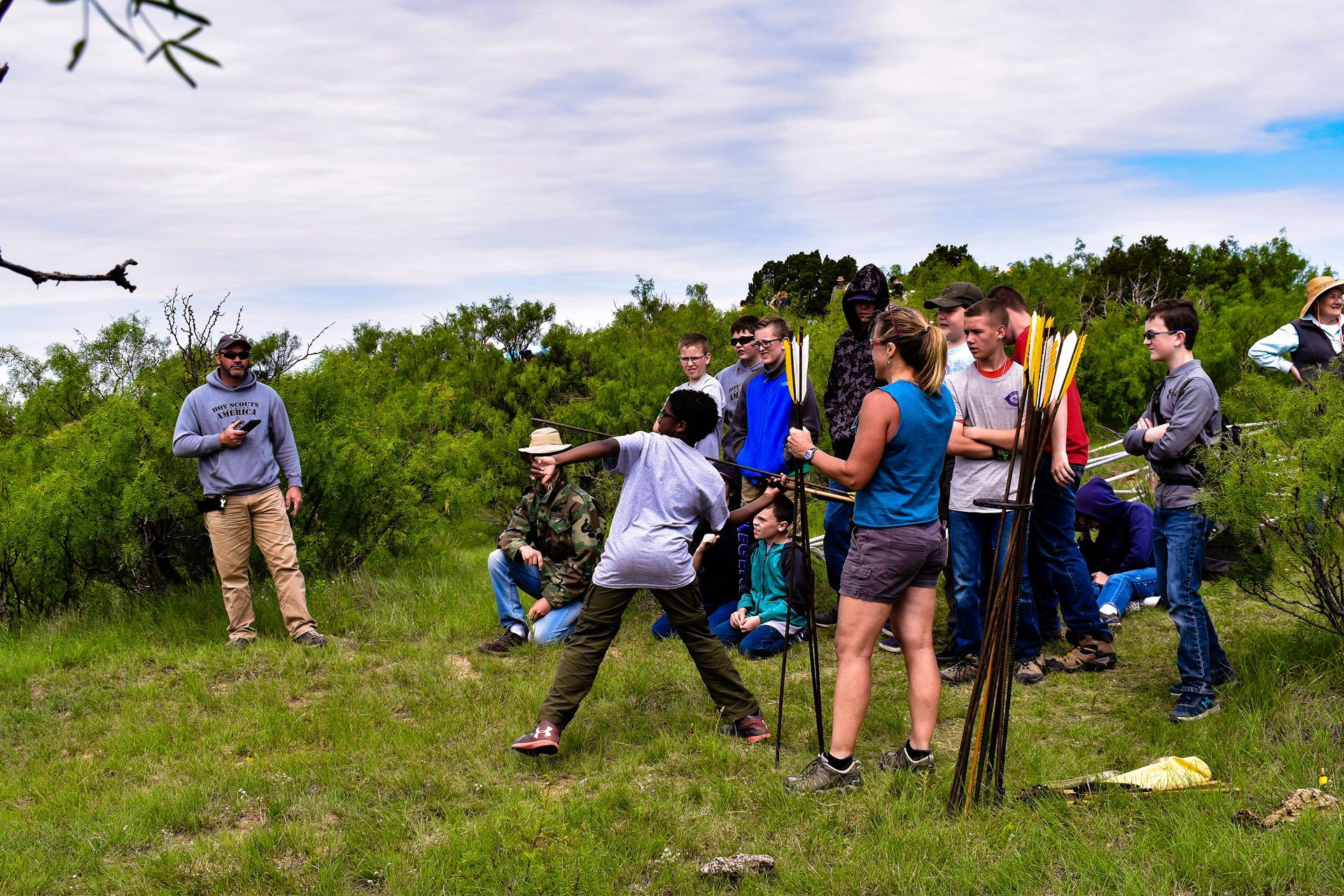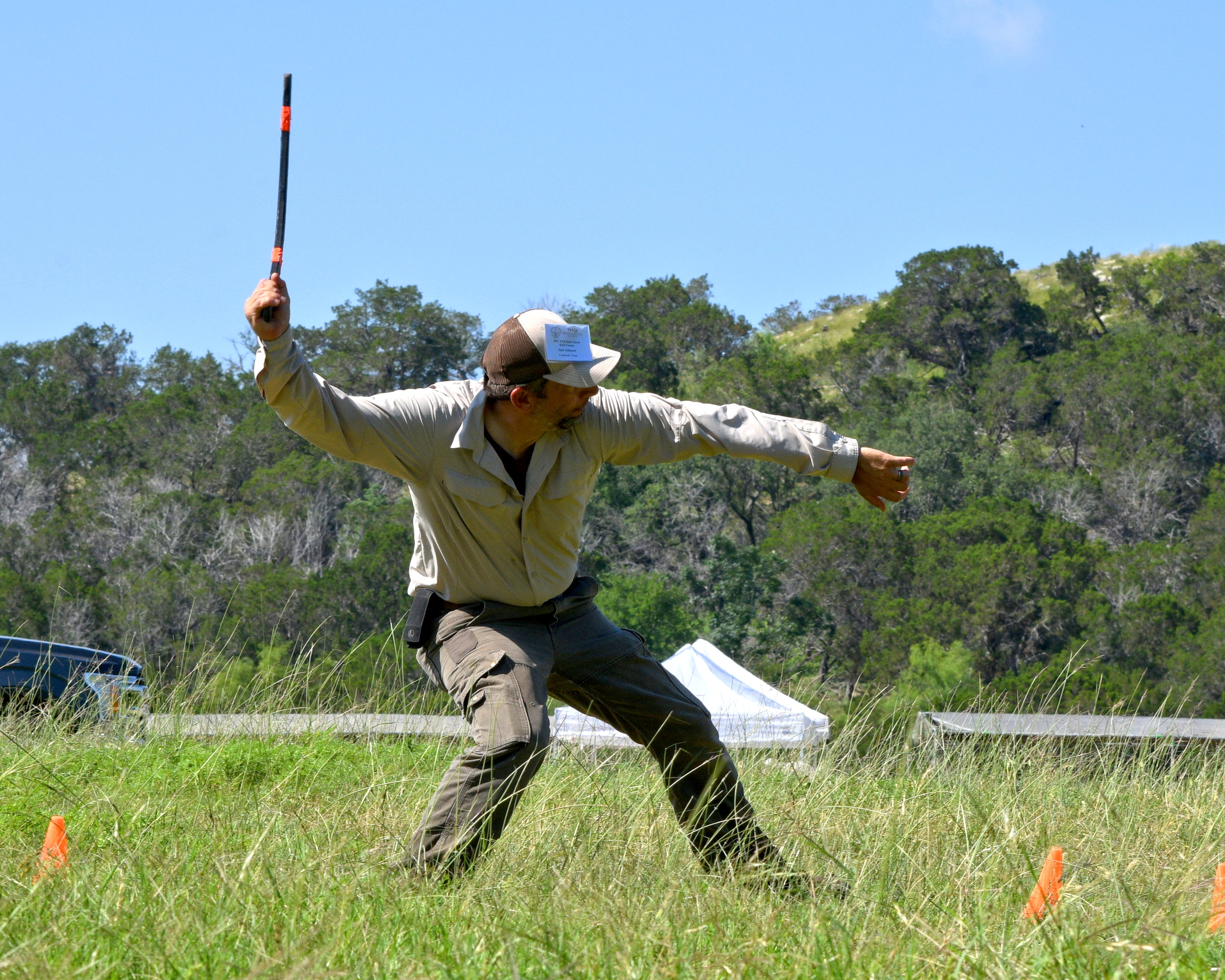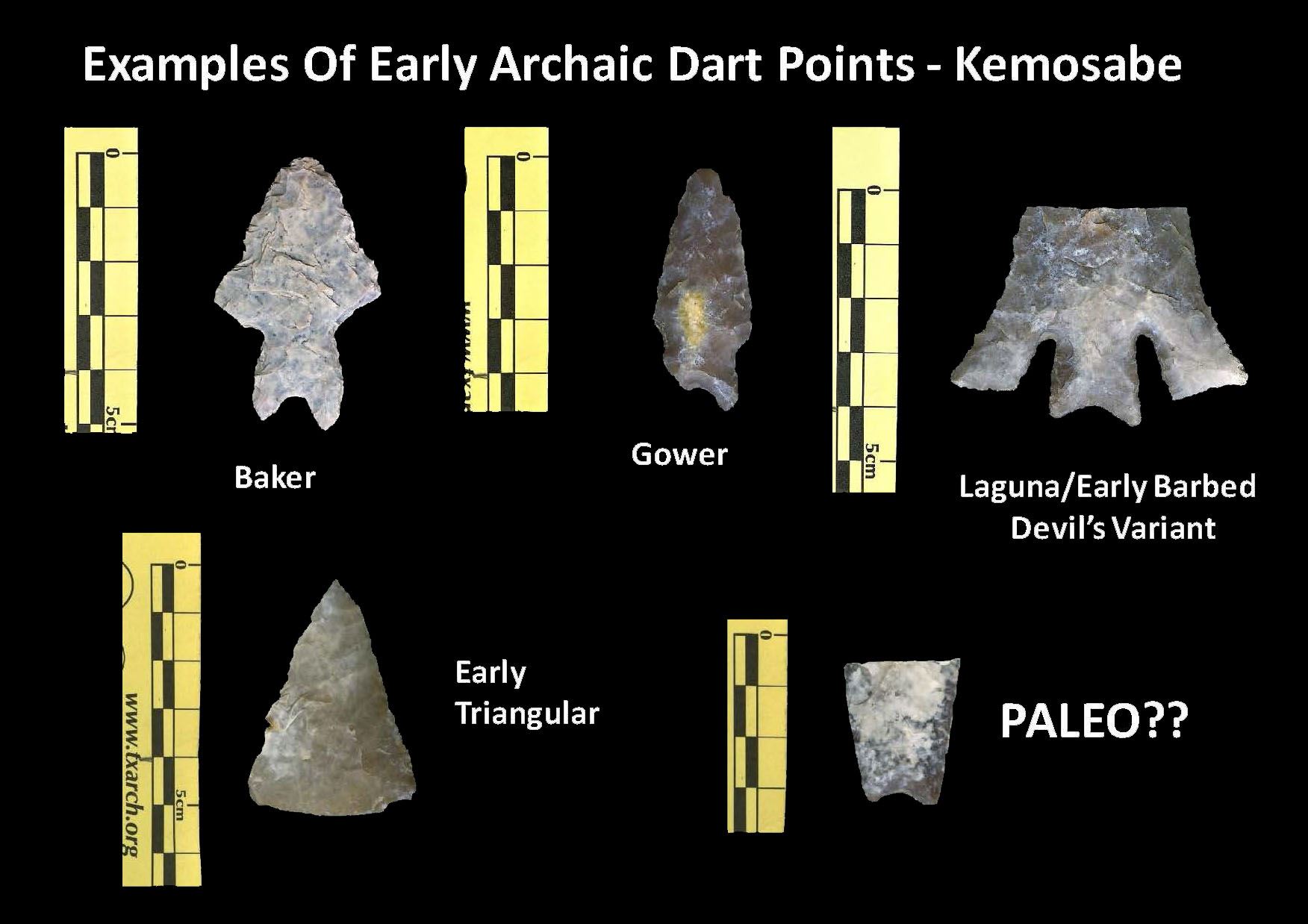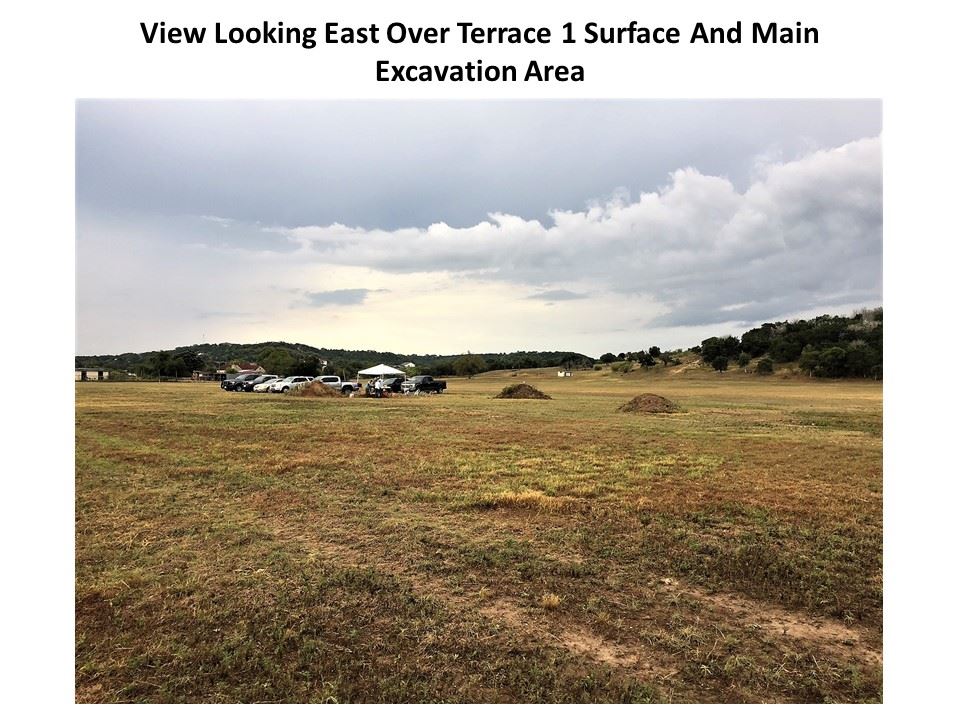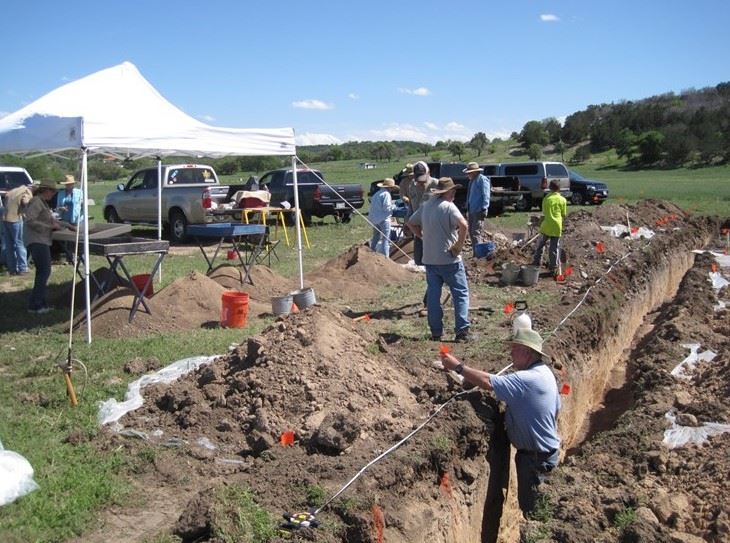 |
Welcome to Kerrville 2022! June 11-18, 2022 REGISTRATION IS NOW OPEN - SEE THE MAIN FIELD SCHOOL PAGE FOR MORE INFORMATION AND LINKS For a summary of events throughout the week of fieldschool: The 2022 Field School Manual is available for download. This year, the Texas Archeological Society (TAS) invites members to attend the annual summer Field School along the banks of the Guadalupe River in Kerr County. TAS is being welcomed with open arms by the Hill Country Archeological Association (HCAA) and Kerr County. Mail in and online registration is now open! Camping The main TAS campground will be located in River Star Park. Flat Rock Park, though less secure, is adjacent and will also available for use. Registration, meals, and evening programs will be held at the Pavilion in River Star Park. When you arrive Friday to set up your camp in the park or check into your hotel, come to the registration area to sign in and receive your name tag, crew assignments, and other information. Unlike our accommodations at Palo Duro Canyon SP, these parks do not offer formal campsites with water and electricity. There are electrical outlets available throughout River Star Park for battery charging and other necessities, but these will all be shared between campers. Potable water is also available in River Star Park near the main pavilion as well as a few other locations in the park. River Star Park offers the best security to TAS campers, this park is fenced entirely and will be locked to outsiders during the day and night. Jack Pool, our camp boss will be stationed near the Pavilion at River Star Park. Flat Rock Park is just downhill and adjacent to River Star Park right along the river’s edge. This park is not fenced but we will be able to control vehicle entry through a gate. No electrical outlets are available in this park. There are numerous shade trees in both parks but as always we encourage attendees to bring a shade shelter for use in camp or in the field. The cooking trailer will be conveniently located near registration at the Pavilion in River Star Park. Registrants may prepare your own meals, or our cooks will be serving breakfast and supper all week for paying customers. See the registration form to sign up for meals. Ice will also be available for purchase near the registration area. Portable toilets will be scattered throughout the campground and adjacent to the excavation areas. A trash container will be provided at camp for your use, so bag your trash and use the dumpsters. Please see the General Info and Camp page for what to expect in camp, camp rules, suggested camp equipment and a general daily schedule. The camp boss or designee will remain in camp during the day to provide security of River Star Park. Nearby Lodging and Restaurants As always, we encourage TAS members to camp at the arranged field school campground and join us for breakfast and evening meals. However, for those requiring alternatives, there are numerous hotels, RV parks, and other accommodations available in the Kerrville area. Please visit the Kerrville Convention and Visitors Bureau website at www.kerrvilletexascvb.com for links containing a wealth of information about accommodations, dining, and "things to do". 2022 Field School Activities
Activities include evening lectures, workshops, the Archeolympics competition, and of course the Wally margarita party with live music. Also, teachers receive CPE credit hours for most Field School activities including afternoon and evening programs (please indicate your interest on the registration form). On Thursday evening of field school, the TAS will host an artifact identification night and public presentation for the local community. Professional and avocational archeologists will be available to provide artifact type identifications and other information about private collections. We encourage everyone to come and talk with the archeologists about their artifacts and the unique history of the Kerrville area! This event will take place at the Pavilion at River Star Park. The 2022 TAS Field School in Kerrville will also offer a unique opportunity to participate in a cemetery workshop hosted by the Texas Historical Commission’s Cemetery Preservation Program. The workshop will include on-site, hands-on learning opportunities covering cemetery topics such as research, site recording, archeological investigations, preservation, remote sensing demonstrations, and tours of local cemeteries with various challenges and/or cultural influences. This low-impact workshop will be offered during our workday on Monday and Tuesday and participants of any skill level can join us for one or two days. If you are interested in attending any of the cemetery activities, you will need to complete the workshop registration form by clicking on the link in your registration confirmation email. This workshop has an enrollment limit, so please register early if you are interested. Archeolympics 2022 All are invited to compete in the seventh annual field school Archeolympics on Wednesday. Archeolympics are a series of games and activities designed mostly to test knowledge of tasks, or skills, that prehistoric people relied on for daily survival, such as hunting skills and fire starting. This event is all about having fun and learning about ancient lifeways. This year we will have three primitive skill events, Friction Fire Starting, Atlatl and Rabbit Stick throwing. We may also have a couple of other events, Cordage Making and 1-x-1 m Unit Layout. Sign-up sheets will be available during Field School and we look forward to having lots of folks give it a try. For fire starting, participants must provide their own spindle, hearth board, and kindling. Both hand and bow drills are fine and the first person to produce a visible flame will be the winner. Rabbit stick throwing will have two categories, youth 12 and under and adult 13 and over. Soccer balls will be used as targets simulating small game and scoring will be for accuracy. Rabbit Sticks will be provided but you may bring your own. The Atlatl competition will be divided into novice and skilled classes. We will probably have enough darts for all but if you have an atlatl and darts, please bring them. There will also be a team contest with 2-5 person teams. Targets will be set up on hay bales and again, accuracy will determine winners. If you have your own atlatl or darts, consider bringing them. Sign up will be available at registration. Several instructors will be available to help you practice to win! The Archeology The subjects of archeological investigation are rich this year. The primary Field School goal will include excavation of a prehistoric archeological site on a terrace of the Guadalupe River and the historic component will excavate and map a historic community dancehall and one room schoolhouse. The Youth Group will have an exciting excavation area as well at the main prehistoric site. As always participants can choose to spend the week conducting prehistoric excavation, survey, or lab. The survey option offers the opportunity to discover new archeological sites and learn proper recording techniques on nearby ranches while the lab participants will help process the volumes of artifacts as they come in from the field excavations. The dates for the 2022 Field School will be June 11-18. We know this will be a field school to remember! |
| Burned rock, lithic debitage, and the occasional tool projectile point, are visible on the surface where the oldest diagnostic artifact, a Late Paleoindian dart point (ca. 8,500 years B.P.), and the youngest, an arrow point (ca. 800 B.P.) were recovered. However, the significance of the site lies beneath the surface, where HCAA have recorded archeological deposits spanning the Archaic (ca. 8,500-1,200 B.P), beginning with an Early Archaic hearth, dated with charcoal to ca. 7,400 years B.P., and associated Bandy dart point. The Early Archaic was a period of climatic transition to which the inhabitants of Central Texas adapted by adopting new foods and cooking methods. We see this at the 41KR744-Kemosabe Site- with the numerous rock hearths and evidence of earth ovens, a cooking technique requiring long periods of cooking, access to limestone, and firewood. This tradition continued for thousands of years, culminating in the creation of at least four burned rock middens. The surrounding environment contains abundant resources for the inhabitants-a variety of plants and animals, water, limestone and access to a variety of excellent chert deposits in rounded and tabular cobbles and chunks. This chert was used to make tools for use at the site and elsewhere. We know people traveled and traded across regions in Texas and beyond, and that Hill Country chert was carried or traded long distances from the source. Rivers such as the Guadalupe may have served as travel corridors between the Central Plains and the Texas coast. Having a record of human activity and environmental data spanning thousands of years, allows us to explore changes through time at one location. At many Central Texas sites, thousands of years of occupation are intermixed and it is difficult to associate material and features with a distinct moment. At the field school, we will investigate a range of Archaic occupations represented in the buried deposits, with discrete features providing opportunity to collect detailed information about climate and the environment, technology, food, and social structure and interactions as snapshots in time. Less than 800 meters to the east is the Gatlin Site (41KR621), excavated and analyzed from 2003 to 2008. The Gatlin Site is on the same terrace and is likely contemporaneous with 41KR744 and this gives us the opportunity to contrast and compare two locations. Initial comparison suggests the sites were used for different purposes. |
Objectives of the 2021 and 2022 TAS Field Schools: Preserved distinct and discrete features are essential to creating an accurate cultural and paleoenvironment record. The field school investigations will:
|
|
2021 TAS Field School Director Eric R. Oksanen I’m Eric Oksanen, the supervising archeologist for the 2022 Kerrville field school. When not at field school, I am a staff archeologist at the Texas Department of Transportation with 25 years archeological experience throughout Texas. My introduction to archeology was at the University of Toronto, where I studied history and archeometry and conducted my first field work – winter-time remote sensing surveys at First Nations sites and nineteenth century historic sites. I discovered archeology in Texas was a warmer paying job. In 2003 I had the good fortune to join the first graduate class in Anthropology at Texas State University. in San Marcos at the invitation of Britt Bousman. I started class three days after the birth of our daughter, Elizabeth, whom I carried around campus and occasionally penned in a 1-x-1. Working for the Center of Archeological Studies (CAS), I conducted field work in Texas and in South Africa. My main area of research has been the Late Paleoindian transition to the Early Archaic. My thesis examined the Late Paleoindian and Early Archaic occupations at the edge of the Balcones Escarpment and the Blackland Prairie. At SWCA, I spent two (?!) years examining the extensive trove of data and artifacts from the Gatlin Site (41KR621), SWCA’s data recovery excavations in Kerrville for TxDOT. The Gatlin Site is approximately 800 meters from the 2020 field school. Years later, after I joined TxDOT, Steve Stoutamire and the Hill Country Archeological Association were kind to host me on several occasions to lecture on the Gatlin Site. It was during one of these meetings that they showed me artifacts from a nearby property and introduced me to the owner, Marvin Gohlke. Marvin’s site had similar diagnostics and sediments but several significant differences. The enthusiasm of the HCAA and Marvin’s stewardship of his property were key factors for accepting the role of field school archeologist. As a TxDOT archeologist, Marvin’s backhoe was another enticement. I currently live in the hinterlands between Buda and South Austin with my wife, Alison, and our five children, Monica, Elizabeth, David, Sarah Jane, and Violet, some cats, and a guinea pig. My spare time is spent experiencing our fine state highway system between Buda, north Austin, and San Marcos. Any remaining spare time is then used making vegetarian lomein and fried rice, and washing dishes. | Selected Reading: Houk, Brett A., Kevin A. Miller, Eric R. Oksanen (2008) The Gatlin Site (41KR621): Investigating Archaic Lifeways on the Southern Edwards Plateau of Central Texas. SWCA Environmental Consultants, Austin. Texas Department of Transportation, Austin. Download: https://scholarworks.sfasu.edu/ita/vol2008/iss1/1/ Houk, Brett A., Kevin A. Miller, Eric R. Oksanen (2009) "The Gatlin Site and the Early-to-Middle Archaic Chronology of the Southern Edwards Plateau, Texas." Bulletin of the Texas Archeological Society 80:51-75. Black, Stephen L. and Alston V. Thoms (2004) "Hunter-Gatherer Earth Ovens in the Archaeological Record: Fundamental Concepts." American Antiquity 79(2):203-226. Collins, Michael B. (2004) Archeology in Central Texas. In The Prehistory of Texas, edited by Timothy K. Perttula, pp. 101-126. Texas A&M University Press, College Station. (1995) "Forty Years of Archeology in Central Texas." Bulletin of the Texas Archeological Society 66:361-400. Download : https://texashistory.unt.edu/ark:/67531/metapth1013928/ Hester, Thomas R. (2004) "The Prehistory of South Texas." In The Prehistory of Texas, edited by Timothy K. Perttula, pp. 127-154. Texas A&M University Press, College Station. Thoms, Alston V. and Patricia A. Claubaugh (2011) The Archaic Period at the Richard Beene Site: Six Thousand Years of Hunter-Gatherer Family Cookery in South-Central North America. Bulletin of the Texas Archeological Society 82: 77-116. Collins, Michael B. (2011) Heated Rocks as Evidence of Prehistoric Hunter-Gatherer Adaptations in Texas. Bulletin of the Texas Archeological Society 82: 181:192 Schroeder, Eric A. (2011) The Armstrong Site: A Transitional Archaic Occupation along the Eastern Balcones Escarpment. Bulletin of the Texas Archeological Society 82: 117-134. Karbula, James W., John A. Campbell, and Bradford M. Jones (2011) The Berdoll Site: An Early Archaic Camp on Onion Creek, Travis County, Texas. Bulletin of the Texas Archeological Society 82:135-174. Look through the BTAS 82 from 2011 with articles about the Texas Archaic- general overviews and site-specific. And it’s downloadable! |
